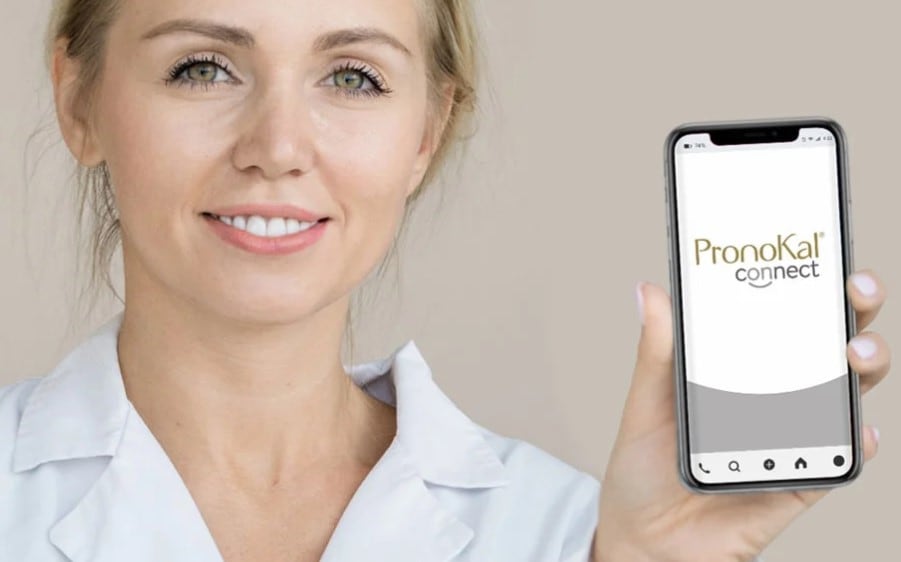Furthermore, with COVID-19 testing becoming an essential part of our lives, virtually everyone on the planet – young or old, healthy or diseased, has conducted health tests on themselves.
The question then, is how user-friendly, how much data, and how accurate the measurements are, which is what this series of VitamINSIGHTS will seek to uncover by surveying the existing technologies and novel innovations.
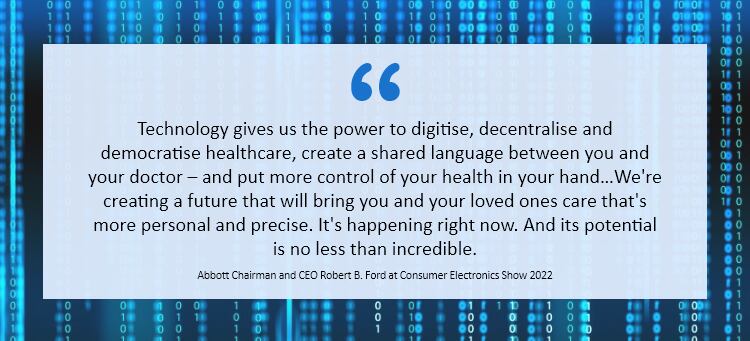
Abbott’s appearance at the Consumer Electronics Show (CES) this year was the first time a healthcare and nutrition company has ever turned up as a keynote presenter at the highly watched tech event.
At the show, CEO Robert B. Ford announced the birth of Lingo – a new category of consumer biowearables that was still under development.
Its purpose? To track the body’s amount of glucose, ketones, and lactate, so that actions could be taken for better health.
“This will be like having a window into your body,” Ford described.
The following infographic gives a snapshot of the types of diagnostic tools and functions available for home use.
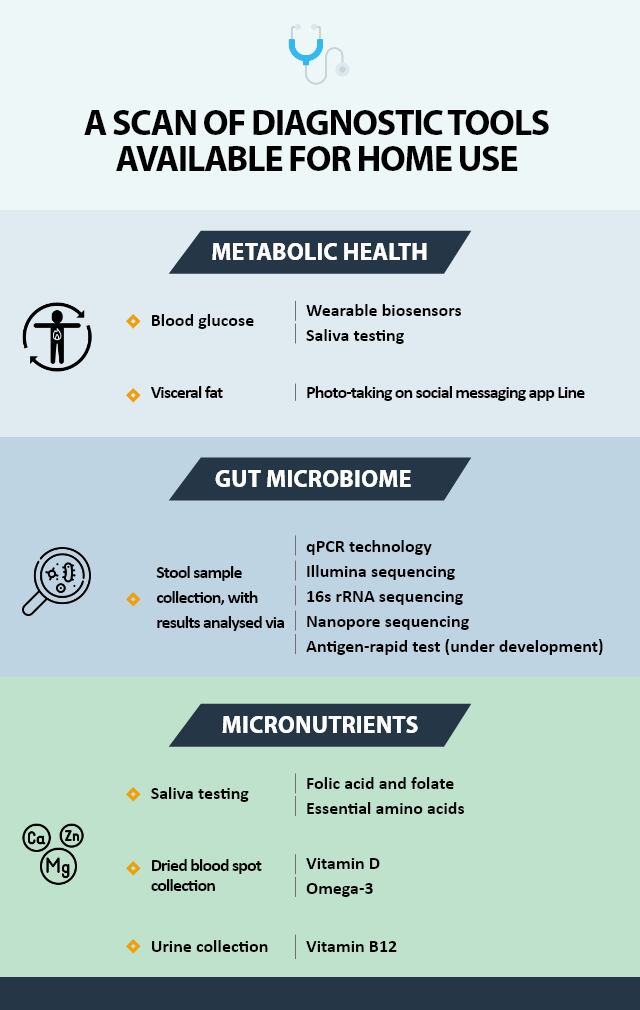
Part Ia: Tracking metabolic health – Glucose
Abbott is no stranger to the biowearables sector.
Freestyle Libre, which uses the continuous glucose monitoring (CGM) technology, was launched by the nutrition giant a few years ago.
As its name suggests, the technology provides real-time continuous glucose readings.
Consumers will only need to stick the glucose sensor using an applicator onto the back of the upper arm. They can then use the accompanying reader to scan the sensor to find out their glucose levels.
Each glucose sensor can be worn for 14 days.
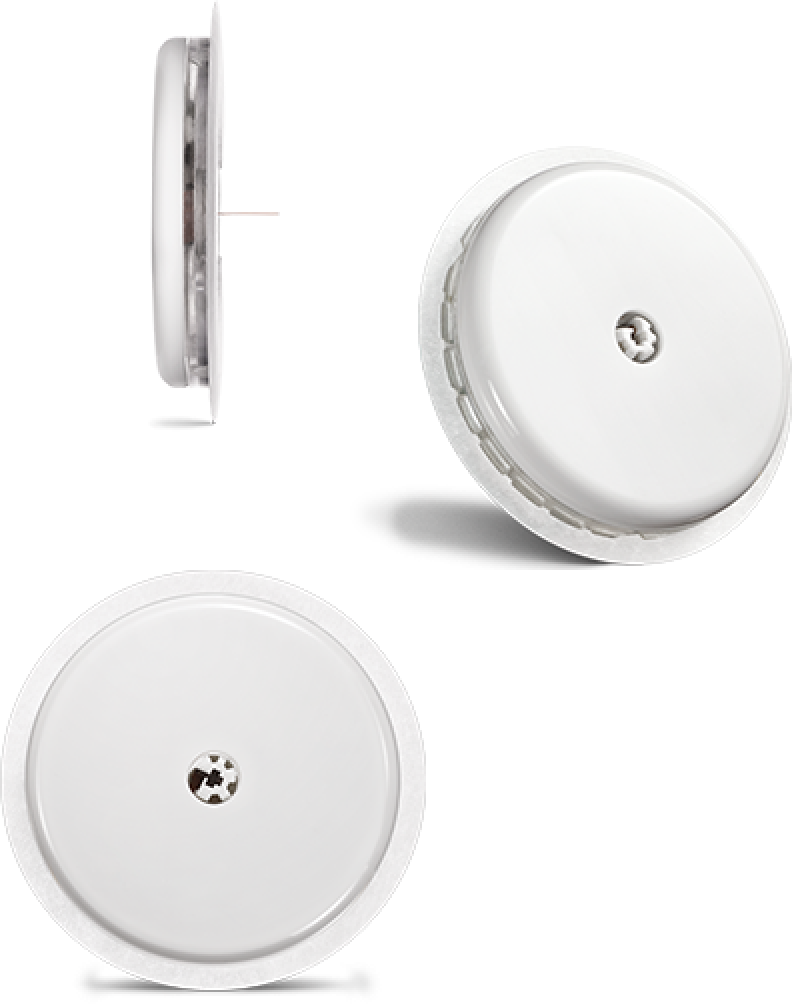
The sensor measures glucose from the body’s interstitial fluids (ISF) – a thin layer of fluid that surrounds the tissue cells below the skin.
This is a departure from the traditional method of blood glucose testing which uses fingersticks, where users will need to prick their fingertips to collect a small amount of blood for measuring blood glucose.
The CGM technology is also different from the blood glucose monitoring method.
The latter only provides the glucose value at a specific time when a blood drop is read. In contrast, the CGM technology allows users to know their current glucose reading and their eight-hour glucose history.
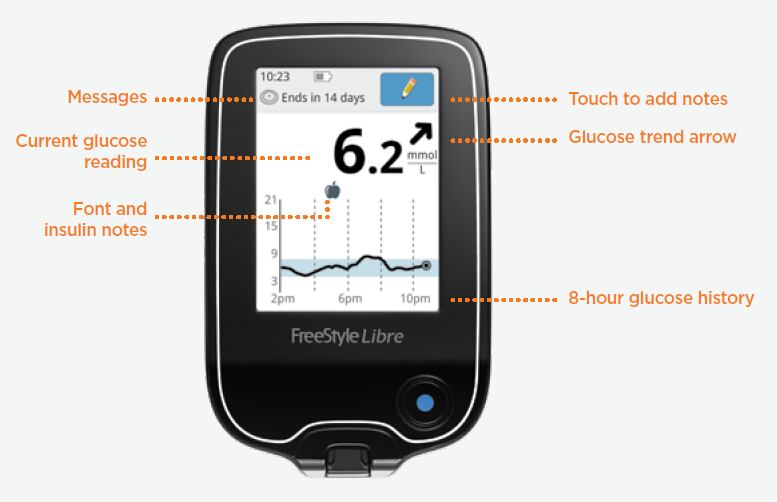
In Malaysia, Abbott started a campaign just after the Chinese New Year celebrations to educate the public to take note of their glucose levels.
The campaign surrounds a four-week activity known as Glucerna Lifestyle Change Program (GLCP).
Each participant that has signed up for the program will be provided with a diagnostic tool such as FreeStyle Libre and Glucerna – the company’s nutritional supplement for diabetic patients.
Another company making in-roads in glucose testing technology is eNano Health from Hong Kong.
Its flagship test kit, known as Kiss & Tell, is a saliva-based glucose monitor.
Users will only need to place the round tip of the test kit under their tongue for two minutes.
Blood glucose readings are presented in different shades of pink.
If a light pink colour shows up on the test kit, it means that the user has a normal blood glucose level. The darker the shade, the higher the blood glucose level.
The test could be conducted before a meal and/or two hours after the start of a meal to monitor changes in their blood glucose level.
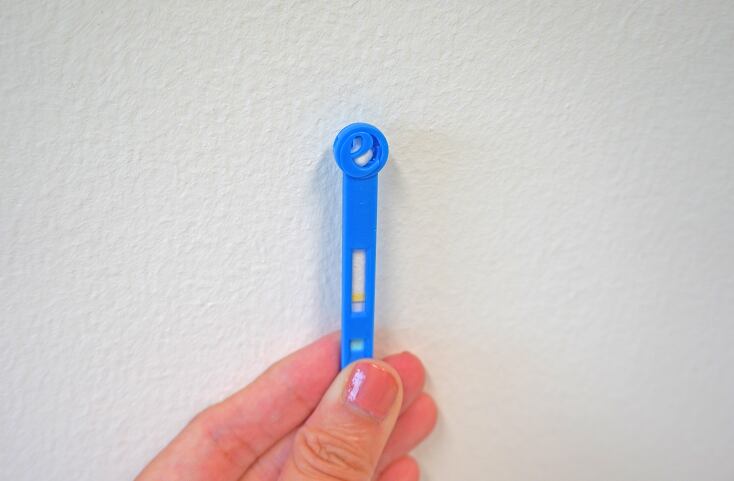
“The saliva-based glucose test is not for diagnosing diabetes, but to help you understand how your lifestyle could affect your glucose levels,” CEO and co-founder Winnie Leung said.
In terms of price, a set of FreeStyle Libre with 4+1 free sensors currently costs SGD$368 (US$270), while one test kit of Kiss & Tell is cheaper at HKD$70 (US$9).
Part Ib: Tracking metabolic health – visceral fat
Elsewhere in Japan, Kao has developed a mobile application for measuring visceral fat.
Traditionally, visceral fat is measured using X-ray or CT scan, which Kao says has impeded the public’s interest in measuring their visceral fat due to the cost involved and exposure to radiation.
Using the mobile app that is found in the social messaging APP LINE, all that the users will need to do is to take two full-body photos of themselves with their clothes on. One photo should be taken from the front and the other from the side.
Usage is free of charge.
How to use the APP?
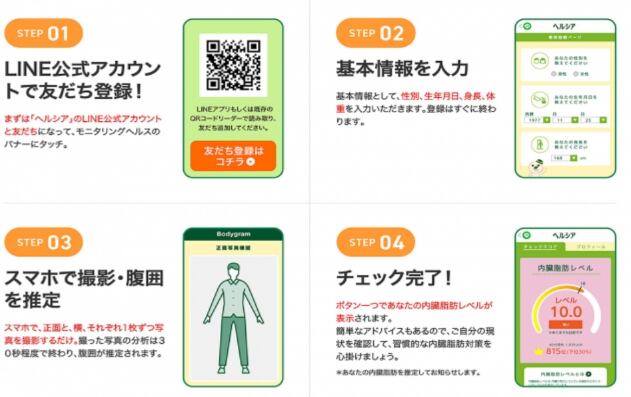
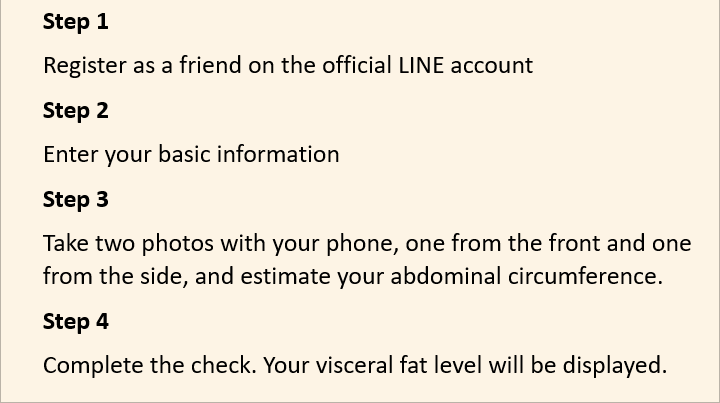
“In Japan, the risk of lifestyle-related diseases is known to increase with the accumulation of visceral fat, and visceral fat measurement was made a mandatory item in the diagnostic criteria for metabolic syndrome.
“Visceral fat can easily increase or decrease depending on your daily lifestyle. Therefore, we developed an application that allows users to easily monitor their visceral fat levels. The idea was to help people improve their lifestyles by checking their visceral fat levels on a daily basis,” Mitsuhiro Katashima, manager, R&D-Health & Wellness Products Research at Kao told us.
There are two elements to the technology.
Visceral fat level is estimated using 1) an algorithm that is created based on the company’s accumulation of visceral fat data from individuals who went for medical check-ups and 2) a body shape estimation system known as Bodygram.
So far, the company’s survey has showed that 58 per cent of the users managed to reduce their visceral fat levels after four weeks of using the service, while this was the case for 76 per cent of them after 11 weeks.
NutraIngredients-Asia understands that this service will be discontinued in June and the company is in the process of developing another technology for visceral fat measuring.
Prior to this service, the company has developed a visceral fat meter that uses the electrical impedance method to measure visceral fat.
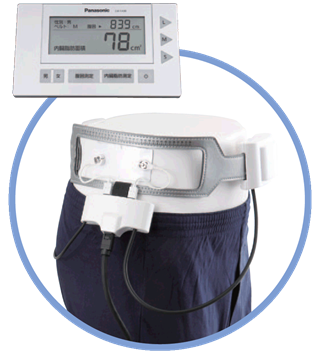
It is now used in healthcare settings during body checkups and medical examinations, which Katashima said had provided visceral fat data to tens of thousands of people.
On the other hand, the company is conducting research on the links between walking and health. It has also developed an activity tracker to monitor walking.
“One of the parameters that we are currently focusing on is walking. There have been many reports on the relationship between walking and health, and Kao is studying the relationship not only in terms of the number of steps taken, but also in terms of walking speed and gait,” Katashima said.
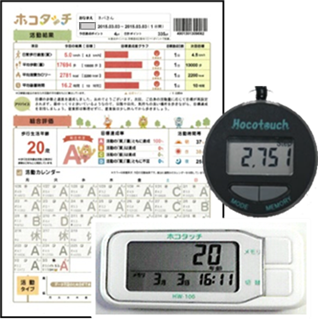
Part II: Tracking gut microbiome
The gut microbiome is another area that has received tremendous amount of interest from the nutrition industry.
Designs For Health Australia, a practitioner-only supplement firm, has been offering the GI-Map Test to help health care practitioners better assess their patients’ gut problems.
Stool samples collected will be analysed using the quantitative PCR (qPCR) technology.
The test is ideal for individuals suffering from digestive problems such as constipation, diarrhoea, bloating, reflux, stomach pain, irritable bowel and inflammatory bowel conditions.
The GI-Map test is developed and owned by Diagnostic Solutions Laboratories – a company which Designs For Health Inc (USA) has a major share in.
Priced at about AUD$400 (US$286), there is no government subsidy of the test in Australia.
Speaking to NutraIngredients-Asia, Peter Barraket, managing director of Designs For Health Australia, pointed out that in general, health diagnostic tools can be better designed by reducing the complexity of the findings and also giving users the ease in conducting retests.
This will allow users to track whether a particular dietary or lifestyle change is effective in improving their health.
Watch the video to find out more.
Elsewhere in Thailand, a researcher from Chulalongkorn University has developed a gut microbiome bacteria test kit that works like the antigen rapid test (ART) for detecting COVID-19.
Users will need to load their stool specimen into the test kit and add in the buffer solution.
Just like the COVID-19 ART test kit, they will need to wait 15 minutes for the test kit to show the results.
Each test kit is marked with four lines: H, M, L, and C, which stands for ‘high’, ‘middle’, ‘low’, and ‘control’.

The C line will show up each time during the test and depending on the amount of lactic acid bacteria detected in the stool specimen, the second line will show up at either the H, M, or L line.
Each test kit is designed to measure the amount of only a certain type of bacteria. For example, users who want to know the amount of Bifidobacterium longum in their gut will need to purchase the specific test kit for doing so.
The inventor, Dr. Krit Pongpirul, currently an assistant professor at the Department of Preventive and Social Medicine, Faculty of Medicine, told us that he planned to commercialise the first test kit – for measuring Lactobacillus plantarum – within this year.
The test kit works via the antibody-based technology.
“The more antigen in the specimen, the more likely you get to the M or H level…This can be done in a clinic or at home by the consumers, anywhere,” he said.
The purpose of the test kit is to help users identify the types of beneficial bacteria that is lacking in their gut so that they could choose the right type of probiotic supplements.
Part III: Tracking micronutrients
Micronutrients, especially vitamin D, C, and zinc are highlighted for their ability to boost immune health amid the COVID-19 pandemic.
For example, vitamin B12, D, and magnesium supplementation has been shown to reduce COVID-19 severity in older patients, according to a cohort study in Singapore.
Against the backdrop, various health and nutrition companies such as P&G, Holista Colltech, and Blackmores, have also launched new supplements containing vitamin D to stay relevant to new scientific findings and trends.
The vitamin is also essential for bone development in children and skeletal health in adults.
To help consumers measure vitamin D levels, US-headquartered OmegaQuant, for example, has developed a test kit that uses the dried blood spot collection method.
Users will need to prick their fingertips to collect three blood drops on a collection card which is then mailed to the company for analysis.
The analysis measures vitamin D concentrations in the plasma instead of red blood cells.
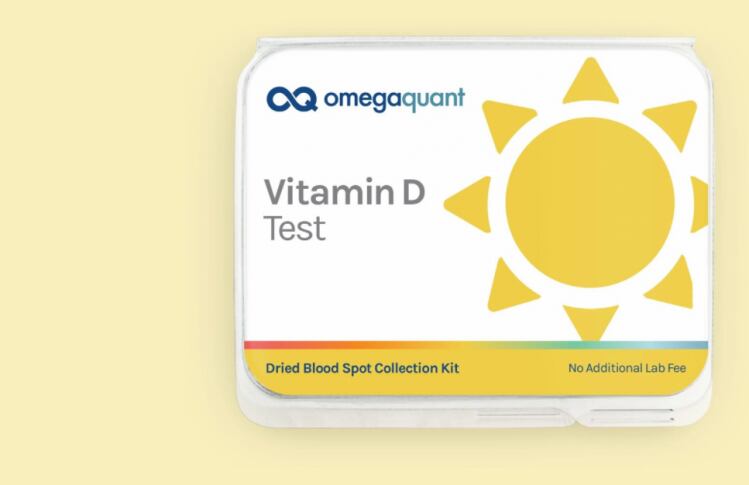
Results will be out in two to four weeks and there would be recommendations to change their diets. The test kit is sold at US$49.95.
OmegaQuant is also known for its flagship omega-3 test kit, which also works in the same way as the vitamin D test.
The difference is that omega-3 is measured based on red blood cells and not based on the plasma.
“We were created out of a research lab that analysed omega three fatty acids. The reason why the lab came to be was to offer omega three fatty acid status testing to doctors and individuals.
“As we started to serve more and more customers, they wanted more options for testing. Our guiding principles are to make sure that the tests are accurate, actionable, which means essentially, one can change the number [shown on the health tests] with a lifestyle change and/or food supplements without taking medicines.
“So vitamin D was really the next obvious choice that has a tonne of research behind it, which is even more so now [amid COVID-19]. It is fairly commonly measured,” director of research, Dr Kristina Jackson told us the reasons for introducing the omega-3 and vitamin D status testing services.
CEO Jason Polreis added that vitamin D testing was also introduced due to consumer demand. However, the demand predated the COVID-19 outbreak.
In contrast to full blood draw, Polreis explained that the dried blood spot testing that it used to measure vitamin D and omega-3 could stabilise the sample for a longer period of time, was easier to be transported around, and was also more cost effective.
Within APAC, the company is currently active in Australia, New Zealand, Singapore, Taiwan, Hong Kong, and Malaysia. The test kits are available to consumers via medical clinics, healthcare practitioners, pathology labs, but not in the retail channels.
“The interest in APAC is definitely picking up. Some challenges include regulatory hurdles that we had to overcome in certain countries, and we are working through the challenges.
“Also, in APAC, it’s a different healthcare model that we have in the US as well, so there was a bit of a learning curve as well,” Polreis said, adding that the company hoped to partner healthcare, supplement brands which would want to offer personalised nutrition services.
The cost involved, however, might not come down anytime soon.

“Offering more affordable [testing] is tough in this market because we use a lot of expensive equipment in the laboratory and it takes a lot of R&D to develop these analytic testings as well.
“I think eventually the smartphone is going to be involved in being able to either directly analyse nutrition markers or other markers, or indirectly be involved as well.
“That should, in theory, make it more economically affordable but the technology isn't quite there yet to be usable,” he explained.
Last year, OmegaQuant also launched a urine test for measuring methylamalonic acid, which is a marker for vitamin B12. The higher the amount of methylamalonic acid, the more likely one is lacking in vitamin B12.
Similarly, the test can be conducted at home and the sample mailed to the company for analysis. It is currently available in the US but would be introduced to the APAC markets.
This year, the company hoped to upgrade its services by allowing multiple testing of different health markers using just one sample collection kit. It is also working on a HbA1C test.
On the other hand, eNano Health has also introduced the saliva testing for measuring essential amino acids and folic acid.
The tests work in the same way as its Kiss & Tell glucose test.
In closing
With the rise of data science, AI, and machine learning etc, the advances in technological advancement are bound to bring in more ways in how we measure health metrics.
However, these technologies will need to be user-friendly and yield easy to understand data to promote long-term uptake from consumers.





